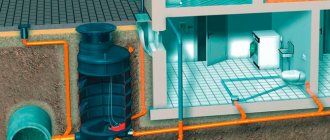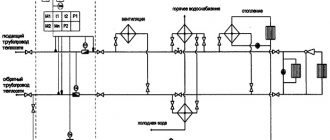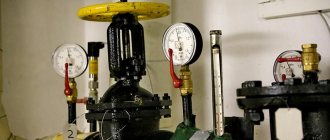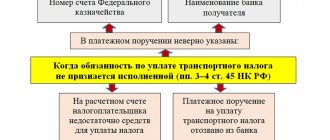How to check if hot water charges have been charged correctly
Housing and communal services receipts for payment of utility services sometimes contain strange names and abbreviations: abbreviations DHW KPU, DHW DPU, water heating service, etc.
This makes consumers nervous and suspicious of tariffs and charges.
Regulation of tariffs for hot and cold water supply, as well as sanitation, is carried out by the state, on the basis of Russian Government Decree No. 406, adopted back in 2013. This article contains information in simple words:
- explanation of what DHW KPU (DPU) and water heating are;
- calculation of consumed thermal energy;
- checking the correctness of charges for hot water supply in the receipt.
Hot water supply: tariff system, control metering devices
First the decoding:
- DHW KPU - hot water supply according to control metering devices;
- DHW DPU - hot water supply via household metering devices.
Hot water control units can be installed in apartments and used as individual metering devices for hot and cold water consumption. The housing and communal services receipt must indicate the readings of both communal and individual meters.
Payment for hot water supply is charged only if there is a central hot water supply, while water is used both as a heat carrier for heating premises and for domestic needs (as hot water).
- If there is hot water in the house, then consumption should be recorded using two general house or individual meters: one is installed on the hot water risers and shows the consumption consumption in cubic meters, the other - on the branch of the heating system and shows the amount of thermal energy consumed in Gcal.
- In houses where there is only cold water, charges for hot water are charged only during the heating season.
- If an apartment uses a boiler or gas water heater to heat water, residents pay for the energy consumed (electricity or gas).
- Some MKD apartments use a dual-circuit heating system: one is connected to the central hot water supply system;
- the other to individual internal water heaters (in case the hot water is turned off).
Tariffs for hot water supply
According to section II, clause 4 of post. No. 406, regulated state tariffs for hot water supply consist of tariffs of the following type:
- for hot water;
- for transportation through the central hot water pipeline;
- to connect the in-house system to the central system (CS) of hot water supply.
How are hot water tariffs set?
Clause 88 of Resolution No. 406 establishes a 2-component tariff for hot water, which consists of a component for cold water and a component for thermal energy (or water heating).
Thus, the cost of hot water Sgw is determined as the sum of the costs of cold water Sxv and its heating (heat energy) Ste:
Sgv = Sхv + Ste (1).
Previously, the cost of hot water was determined by f‑le:
Sgv = Vgv x Tgv (2), where
Vgv - volume of hot water consumed,
Tgv - tariff for hot water (cost of one cubic meter of hot water).
For reference: The cost of one cubic meter of hot water in Moscow in the second half of 2020 was 188.5 rubles per cubic meter.
Attention! If payments for hot water in housing cooperatives or management companies are carried out according to the old one-component tariff for hot water, then residents should not be charged for any water heating!
Calculation of the cold water component
The cold water component is determined:
- at the standard price of one cubic meter (single-rate system);
- at the price of a cubic meter plus the power expended per hour per 1 m3 of water (according to a two-rate system).
That is, the tariff for cold water can also be composed of two components.
If water is taken from a water supply source by some third-party organization that has the right to do so, or is processed to turn it into drinking water, then the tariff for cold water can be set based on the material costs of this organization per 1 m3 of water.
Formula for determining the cost of cold water Sхв used for hot water supply:
Sхв = V x Тхв (3),
where V is the consumed volume, which is removed from the hot water meter;
Тхв - tariff for cold water.
What is thermal energy
Thermal energy is the power required to heat water, measured in gigacalories.
That is, this is the same “water heating” that can be indicated on the receipt as part of the tariff for hot water. It is included in this tariff along with the cold water component, and is not a separate fee.
(Explanation for those residents who are sure that the housing and communal services authorities charge them double fees for hot water).
At the same time, the receipts additionally indicate the fee for cold water, since this is a separate type of utility service.
It was decided to introduce a two-component tariff to take into account energy and transportation costs, as well as heat loss.
In this case, according to the law, only heat losses along the path from the central coolant supply points to the entry point into the houses are taken into account.
That is, no losses from heated towel rails and risers in the premises should be taken into account.
Composition of the thermal energy tariff component
The thermal energy tariff component consists of:
- from the cost of one unit of thermal energy (gigacalories or Gcal), established on a legislative basis;
- financial costs of organizations regulated by the state for the maintenance of central hot water supply from the points of thermal power plants to the point of operational inputs of the zone of responsibility of consumers and organizations;
- the cost of heat loss of one unit of thermal energy (1 Gcal) in pipelines from central heating points to the entrance to the end-user areas;
- cost of water transportation.
Tariffs for thermal energy in the first half of 2020 for residents of Moscow increased by 1.7% and amounted to 1,803 rubles. 24 kopecks for 1 Gcal (supplier Mosenergo). Tariff for hot water by 1.7% - 191 rubles. 73 kopecks per cubic meter m. Tariffs for the second half of the year for heat and hot water: 1864.3 rub. and 198.2 rub. respectively.
How is the thermal energy component determined?
The thermal energy component, according to the decision of the Supreme Court of the Russian Federation dated July 10, 2020, is determined according to regulatory Rule No. 354:
This is the amount of thermal energy spent on heating the volume of water consumed by the consumer, which is determined not by metering devices (KPU or DPU), but by standard indicators of heat consumption for heating.
If we take the amount of energy for heating water as a certain value Qgw, then the cost of thermal energy Ste, at the heat tariff Tte, can be determined by the formula: Ste = Qgw x Tte (4).
In this case, Qgw in the absence of heat consumption metering devices (heat meters) is calculated according to the thermal energy standard per cubic meter of water and the volume of water consumed:
Qgv = V x Npv (5),
where V is the volume of hot water (according to the hot water meter installed on the branches of the heating system);
Npv is the standard for heating one cubic meter of water (on average it ranges from 0.05 to 0.07 Gcal/m3).
How to check the correctness of charges for hot water supply
The cost of hot water is calculated as follows:
- according to metering devices (hot water meters) - they determine the volume of water consumed, and according to f‑le (3) the cost of the first component - cold water;
- using formula (4) for calculating the cost of thermal energy, the cost of the second component is determined;
- add both components.
In addition to the payment for hot water, the receipts indicate the payment for heating, which is calculated according to the readings of communal or individual heat energy consumption meters.
Calculation of DHW if there are no meters
If there are neither communal nor individual meters, then payments for hot water and heating are calculated according to average standard indicators established by regional authorities:
- standard water consumption per person per month (it is inserted into formulas (3) and (5) instead of the volume of water according to the meter);
- standard consumption of thermal energy per square meter of total area;
To determine the cost of heating, it is necessary to multiply the standard indicator of thermal energy consumption by the area of the heated premises of the apartment, and multiply the resulting result by the tariff (the cost of one Gcal of heat).
How to calculate the cost of hot water supply by meters
- The cost of hot water according to a common house meter: the number of cubic meters of hot water consumed per month in the house is divided by the number of residents in the house - you get the average volume of water consumption Vavg. for one person;
- Vavg. insert into the lines (1) - (5) instead of V.
= Vted x Sq/Shouse x Tte, where:
- Vted - the volume of thermal energy consumed by the house per month according to the general house thermal energy meter;
Shouse - the total area of the heated premises of the house;
Hidden charges for hot water supply
Repairs of pipelines, water heaters, filling the system before the heating period, draining coolants and other work are not included in the domestic hot water tariff, but are paid in separate columns of receipts: operating costs, technical work, repairs, etc.
It is very difficult to control utility bills here.
It is due to all these additional payments that the unaccounted profits of housing and communal services and management companies are formed.
There are also proven techniques for installing hidden plugs on the heating system of a house behind the meter, which allows you to reduce the supply of real heat to apartments.
Complaints about housing and communal services and management companies
The controlling body for housing and communal services, housing cooperatives and management companies is the State Housing Inspectorate. This is where residents should file complaints if they think that the payment for hot water supply is too high.
The housing inspection is obliged to consider the appeal and respond to it within a month. If the complaint is found to be justified, GZHI inspectors will inspect the hot water supply in the house.
If the complaint is rejected, you can appeal to the courts by filing a claim with representatives of the housing and communal services, housing cooperatives, HOAs or management companies (depending on the nature of the claim).
Even if the money for hot water supply has been paid, then if violations and incorrect calculations are detected when charging fees by the relevant organizations, the paid funds must be returned to the residents.
Otherwise, the persons responsible for returning the money, on the basis of Art.
395 of the Civil Code of the Russian Federation, will be forced to return the amount of the debt with interest or pay a penalty for failure to fulfill obligations (if the condition for payment of the penalty is contained in the agreement between the parties (suppliers, organizations and consumers).
conclusions
- Hot water supply in apartment buildings can be controlled using metering devices (both individual and communal). Almost all MKDs have meters installed to control the hot water supply of the KPU (DPU).
- Calculation of the cost of hot water consists of two components: the cost of cold water and the cost of heating it
- One receipt cannot contain double charges (for both hot water and water heating), since the cost of water heating is included in the cost of hot water).
Loading…
How to understand the EPD for housing and communal services
In addition, the volume of utility services provided is affected by the increase in the number of citizens living or registered in residential premises. Some services are charged for each resident or registered person: gas, and in the absence of individual water meters - cold and hot water supply, sewerage.
Benefits are provided in the form of discounts - for no more than one apartment (residential premises) based on rates, prices and tariffs established by the Moscow Government. If a consumer has the right to social support measures for paying for housing and communal services on two or more grounds, benefits are accrued on one of them.
What is HVS KPU
These letters should be understood as hot water metering, implemented using an apartment meter. In this article, the topic raised will be discussed in particular detail.
Understanding cold water metering
The legislator has established mandatory payments for citizens of the Russian Federation for the use of utility services.
Continuous cold water supply (CWS) stands for continuous supply of a resource of appropriate quality to Russian citizens for use in everyday life.
The state provides for the norm for each consumer and the delivery of water through the municipal system or to special pumps. Accounting for cold water must be carried out in the following ways:
- fixing a specific consumer norm for each person registered in a residential premises;
- providing any housing with a special meter.
The counter (KPU) measures the amount of cold water used per month, after which the data is transferred to the person who provides the service.
Important! A special designation “DPU” will appear in the payment, which indicates the obligatory amount for the use of cold water supply using a home meter.
In the absence of a meter, the determined consumption is calculated from general indicators. This option is not entirely profitable, since thrifty people will have to overpay for the service. The data from the residential premises is taken as a basis.
KPU designation on the receipt
Individuals receive utility bills based on their needs. People are not always fluent in the symbols. Cold water in receipts is no exception.
What is cold water for domestic hot water in the receipt? The following abbreviations are generally used on receipts:
- HVS DPU (deciphering is given above);
- Cold water supply for hot water supply - the so-called supply of cold water for the possibility of using hot water supply. Everything is simple - heating occurs;
- DHW DPU - the amount of water used during the use of hot water supply.
In addition to water supply, utility companies provide wastewater services to people. The latter term should be understood as disposal of used water using sewerage. For this service, special buildings are equipped to process streams of all types. There are three lead designs:
- general. It has only one network for withdrawing all funds;
- separate. Such a system is classified into complete and incomplete.
The first has two closed networks that output resources. The other is for rain accumulations—a half-split drainage design. Divided into household and rainwater. If the networks intersect, then fencing structures are installed to rid the reservoir of excess inflows during rain.
Important! Therefore, the receipts contain a separate item under which fees for services are charged. This is an extremely necessary point in the document. The incredible amount of resource used must be processed before being released into waterways.
Water disposal is calculated as follows:
- First, the needs for time are formed; when specifying data, one should proceed from the results of water consumption per apartment. Reading results may vary by region;
- Some homes may need to use a common household meter. If there is no measuring device, the amount is calculated according to fixed standards.
Consumer protection is equally important. Usually, receipts have lines for water heating in order not to overpay for heating. Pay attention to this. It is possible to create an additional line in a receipt of the established form only if the position of the owner of the premises is agreed upon.
Relationship between DHW and cold water
According to current standards and documents, hot water supply (hot water supply) must be supplied to all populated areas with temperatures up to 75 ° C. The resource is constantly provided to people. Heating points can switch to a more relaxed (summer) mode. Hot water enters the city hot water system and is subsequently distributed to residential premises.
Important! Heating companies produce hot water by heating purchased hot water. As a result, an item such as heating appears on payment receipts. In this case, the data from the common house meter for hot water consumed is taken into account. It is necessary to configure the metering devices correctly by entering the name of the service.
For complex heating of apartment buildings, you should pay for utilities. Some abbreviations are quite simple to decipher. To know what you're paying for, check online or contact your utility company for more details.
Cold water supply (CWS)
For each hour of exceeding the permissible duration of a cold water supply interruption, calculated in total for the billing period in which the excess occurred, the amount of the utility fee for such billing period is reduced by 0.15 percent of the fee.
- The permissible duration of interruption in cold water supply is 8 hours (total) for 1 month
- The permissible duration of a cold water supply interruption is 4 hours at a time, in case of an accident in centralized engineering support networks
- The composition of water must necessarily comply with sanitary standards SNiP 2.04.02-84
- Pressure in the cold water supply system in apartment buildings and residential buildings - from 0.03 MPa (0.3 kgf/sq. cm) to 0.6 MPa (6 kgf/sq. cm)
- The pressure in the cold water supply system at the water taps is not less than 0.1 MPa (1 kgf/sq. cm)
What is the essence of the concept of water disposal, decoding of DPU and KPU in the receipt
The preparation of hot water for the needs of hot water supply occurs in centralized heating boiler houses, in the same place where the coolant of the heating system is heated.
Boiler rooms can be connected to a looped DHW system or be a dead-end type - designed for a group of houses or one house (for example, rooftop boiler rooms).
The closer the consumer is to the source of hot water (boiler room), the better the quality of the service provided and the higher the water temperature.
However, connecting to loop networks is preferable from the point of view of reliability and uninterrupted hot water supply.
The service includes:
- Boiler room maintenance. Unlike heating, hot water supply is provided all year round, while boiler houses switch to summer (minimum) operating mode.
- Trail maintenance.
- Carrying out scheduled repair work on networks.
Water heated in the boiler room for an open (unclosed) DHW system enters consumer apartments through supply water pipes, distributed through intra-house DHW networks.
The temperature of hot water for consumers is regulated by sanitary and legal standards and is +50…+65 °C. In reality, it often does not exceed +40 °C.
This is due to heat losses during the supply of coolant along routes (poor pipe insulation, gusts) or due to low temperature at the outlet of the boiler room. Boiler room operators adjust output parameters based on outside air temperature.
The service provider’s task is to provide apartments with a utility resource of appropriate quality.
Sometimes the heating network justifies poor-quality service provision by the deplorable state of the networks - routes built in the last century that require major repairs will not withstand temperature changes in winter if the parameters of the coolant at the exit from the boiler room are maintained at the standard level.
It turns out to be a vicious circle - many residents often do not pay for hot water due to its low temperature or refuse this service altogether, switching to heating water with electric boilers.
And heating network enterprises cannot carry out repair work, because... the population's debt to pay does not provide them with an influx of cash. In the video about the hot water service
Bottom line
Whether or not to pay for a hot water service if it turns out to be of insufficient quality is a purely personal matter.
It is important to understand that if you decide to take the path of non-payment, you do not need to simply create debts. It is necessary to collect the evidence base according to the following scheme: carry out commission measurements of water temperature, send the results to the company providing the services
Be sure to receive an official response explaining the reasons for the poor quality of the service. Having collected a package of evidence, you can go to court to assert your rights.
Cold water and hot water on the receipt, what is it?
The list of all utility services subject to mandatory payment by consumers is clearly stated in Article 154 of the Housing Code of the Russian Federation. It also states that utility companies have the right to use abbreviations to designate a particular service.
The law states that it is strictly prohibited to change names and their abbreviations, and they must comply with current recommendations. Considering the fact that there are a lot of abbreviations in the receipt, users often have the question of what cold water is.
The abbreviation HVS refers to cold water supply, and the abbreviation DHW refers to hot water supply. In addition, in payment documents the column may contain the term HVS DPU.
It means that payment for consumed cold water occurs on the basis of a common house meter.
If the receipt indicates the HVS KPU, this means that the consumer in the apartment has his own metering device, on the basis of which payments are made.
What is sewerage in utility bills in 2018
In utility bills, drainage is entered on a separate line. To determine the volume of water that goes down the drain, the readings of individual meters for hot and cold water or average monthly consumption standards are used. In the first case, this expense column is often called “Water disposal KPU”.
Since 2013, residents could find an additional line on the receipt “Water disposal ODN”. The abbreviation stands for “General Household Needs.” This is the amount of water that is spent on heating and cleaning entrances, basements, attics, watering house plants, “technical” losses, etc.
From 01/01/2017, the costs of drainage of “general” wastewater must be included in the costs of maintaining the property of the MDK. And their volume is calculated either using standards determined by regional authorities, or the amount of supplied resource according to common house (collective) sewerage meters, and if there are none, according to the water supply control unit.
That is, the management company (HOA, cooperative) does not have the right to write down “Water disposal for the maintenance of collective property” as a separate line. Such an overpayment must be contested through a claim or statement of claim in court.
Read here how to pay utility bills through the terminal.
How is it calculated
Calculation of utility fees in the presence of a utility bill is made using the formula:
Where cold water and hot water are the volume of cold and hot water consumed by apartment residents according to meters for the previous month.
Like other housing and communal services, sewerage is subject to federal or regional benefits:
- for invalids;
- veterans of WWII and other wars;
- heroes of Labor, heroes of Russia and the USSR;
- pensioners;
- large families (having 3 or more children);
- single mothers;
- low-income people and some other categories of citizens.
Benefits are issued at the social welfare department or at the management company. In this case, up to 50% of utility costs will be covered by the federal or regional treasury.
Current tariffs
Tariffs and standards are set by regional authorities. Thus, in the capital in 2020, the Decree of the Government of the Mountains is in force. Moscow No. 848 dated December 13, 2016. According to this act, the rate was indexed in July 2020; sewerage prices have increased by about 7% compared to the previous value.
An increase in fees for housing and communal services in the middle of the year occurred in all regions of the country:
Example. A metropolitan family used 8.3 m³ of cold and 4.1 m³ of hot water during the month according to the apartment meter. The total volume of water supply and, accordingly, wastewater disposal is 12.4 m³. The family must pay for sewerage an amount equal to 12.4 * 25.12 = 311.49 rubles.
If there is no counter
If there are no meters, water disposal is calculated according to the average monthly water consumption standards in force in the constituent entity of the Russian Federation.
The calculation includes the value of the standard, the number of registered (including temporary) residents and the tariff:
Standards are also set at the regional level and depend on the area of the room, the presence and number of baths, sinks or sinks, climate zone, condition of the centralized sewer system, etc.
For example:
Moreover, according to Resolution No. 354, if meters are not installed in a house, but there is a technical possibility for this, the standard is applied with an increasing factor. In 2020 it is 1.5.
Example. A Moscow family of 2 people bought a new building with a mortgage and did not have time to install individual meters in it. Accordingly, it pays for the use and disposal of water according to standards multiplied by the increasing coefficient and the number of registered ones. Thus, the cost of wastewater disposal will be 11.68 * 2 * 25.12 * 1.5 = 880.20 rubles.
They pay for sewerage, like other utilities and housing services, until the 10th of the next month. If you discover an error in the receipt, you need to submit a free-form recalculation application to the management organization (homeowners' association, cooperative). If the issue cannot be resolved amicably, the matter is resolved in the district court at the location of the property.
Here you can find a sample certificate for a subsidy for utility bills.
Ministry of Construction proposes to abolish mandatory social norms for electricity
Counter or standard
Amounts for individual consumption
(utilities used in the apartment) and for
general house needs
(GDN; for example, expenses for heating and lighting of the entrance) in the payment order should be posted in different columns.
There are cases when the amount of payment for the use of utilities per person per person exceeded the amount of individual consumption in apartments.
This can happen when payments to ODN are calculated not according to meters, but according to standards (with an increasing factor due to the lack of a meter).
However, so far the practice is not in favor of residents.
You also need to remember that if more than 10% of a family’s income is spent on paying for housing and communal services in Moscow, you can receive government support in the form of subsidies.
In this case, you must contact the regional department of housing subsidies, presenting a certificate of income and a certificate of ownership. At the same time, there should be no excess living space: the established standards are 33 square meters. m per person, 42 sq. m - for two.
What to do if the bill is too high
If it turns out that the bill is inflated, you need to file a complaint with the management company. If she does not answer, you can file a complaint with the Housing Inspectorate (you can also write there immediately, without waiting for a response from the Criminal Code). You can also contact your regional tariff commission.
“The housing inspectorate can be asked to conduct an inspection, on the basis of which a recalculation will be made.
Payment for gas supply is calculated according to the tariff for each consumer living in the apartment.
Limit indices
The maximum index of changes in the size of citizens' payments for utility services is a universal tool for monitoring charges for hot and cold water supply, sewerage, heating, and gas. Changing the fee above the maximum index is unacceptable and should entail an immediate response from the executive authorities to eliminate this situation.
In the capital, the maximum index was approved by Order of the Mayor of Moscow dated June 30, 2014 No. 542-RM and from November 1 to December 31, 2014 it is 6.5 percent.
If you pay using a home metering device (DPU), the payment document indicates the abbreviations: “HVS DPU”, “DHW DPU” and “Water drain. DPU" - cold and hot water supply, water disposal according to the readings of the house water meter.
What is drainage in utility bills? Payment calculation
There is no division in payments for utility services, therefore the total amount is calculated for the consumption of resources and for services, as stated in the “Rules for the provision of housing and communal services for owners and users of premises.” The meaning of the decree is this: even if your apartment does not consume one of the resources, if you turn it off, you will still have to pay. Example: there is no installation of an individual gas meter for a neighbor, but the house is supplied with gas, you pay not only for yourself, but also for your neighbor.
What is KPU? This question is often asked by users. KPU is a collective metering device installed in a common household manner. In other words, KPU is a counter that shows how much sewage has been drained over a given period of time. However, the abbreviation KPU is not in any official document; in the lines and columns there is “Common house or common house. utility metering devices." It turns out that the KPU is an invention of the housing and communal services sector and nothing more, especially since the use of abbreviated names of devices in official documents is not allowed unless specified by the rules or an addition to the resolution.
We recommend reading: Rosreestr receipt sample
How to pay dpu
This is a separate service for which you need to pay in the same way as for the supply of water and electricity. If a DPU is installed, then the amount of payment for sewerage is calculated based on its readings. How legal is it to charge a penalty for non-payment of housing and communal services under the DPU, if I warned the housing and communal services in writing that Should we pay according to the common house meter for water? How not to pay more for utilities: payment for housing and communal services through Sberbank without commission. DPU metering device for the whole house. For the last three months, bills have been coming in with the item “DHW DPU” (payment for hot water according to the readings of common house metering devices) in the collection bill. And we have stopped altogether It’s not profitable for them to seal the meters, you see, so the meter sits and spins for nothing, and we pay 3 times more. Fight the DPU, otherwise there will be no savings. Also, who will pay for the water used to wash the floors in the corridors? Calculating how much you will have to pay for sewer services is quite simple. The main thing is that water meters are installed in the house. the situation does not change: they brought the receipts. 170 kW consumed in the apartment, DPU - 80 kW, that is, exactly half. in October, September I paid 350 rubles together with DPU Do I need to pay DPU and is it legal to withhold this money from me? Dmitry Shilov: — If you have an agreement with an energy supply organization (energy sales) How to understand the rent receipt and not “pay for air”? For example, hot and cold water supply and domestic hot water supply, and DPU are general house metering devices. In general, I know about the DPU drainage system that from June 1, 2013, the consumption standard is like paying for light according to an apartment meter and according to some common one for the house at the same time. There will be no errors, because “Enter DPU” “does not see” how much payment there was. This is when you hand it over to the Fund, and then it is controlled there. Now you don't have to pay for Light. Payment of receipts through Sberbank online - Duration: 2:02 vera Verochka 60. Water drainage (sewerage) KPU apartment metering device DPUZa what we pay. The services specified in the payment document can be divided into several parts. You will have to pay in accordance with the meter readings. If in the column “HW DPU” or “DHW DPU” the water consumption is indicated as more than 11 m3 per person, there is a possibility that the GPU, or DPU, DHW KPU, DHW DPU. Did the accounting department have the right to include the full volume of individual meter readings and readings for the entire house? What is meant by ODN? If everything is clear with DPU and KPU, then ODN raises many questions. Moreover, the number of residents is not subject to accounting.
We recommend reading: How to divorce your husband in another city
What happens if you don’t pay for this? The amount for the DPU is 242 (!) of the amount for consumed hot water. In response to my arguments that the values according to DPU can be 20-50, but not 242 Those who did not have individual meters were not charged “according to DPU” (they paid only according to the standards). HVS DPU Cold water supply. But I know what the face of the housing department will look like when you announce that you will now pay according to the meter. On the receipt you can find the following designations for drainage: KPU and DPU. What specific services should the tenant pay for when it comes to drainage? HVS DPU - cold water supply (cold water) according to house metering devices. If the KPU is indicated, it means that you pay for water at the apartment rate. They do not take DPU from them, because





